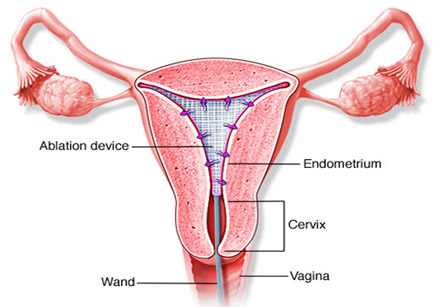Endometrial Ablation
Introduction
Endometrial ablation is used to control heavy, prolonged vaginal bleeding in cases of:
1. Bleeding which has not responded to other treatments.
2. Family is complete.
3. Patient does not prefer a hysterectomy to control bleeding.
4. Other medical problems prevent a hysterectomy.
Results:
Most women have reduced menstrual flow following endometrial ablation. And many women stop having periods after the procedure.
We have all the information you need about public and private clinics and hospitals that provide gynaecological treatment in Iran

Younger women less likely respond to endometrial ablation than older women. Younger women are more likely to continue to have periods may even need a repeat procedure.
Young women are treated with gonadotropin-releasing hormone analogues (GnRH-A) for 1 to 3 months before the procedure. This decreases the production of estrogen and help to thin the lining of the uterus (endometrium).
Risks
Problems that can happen during endometrial ablation include:
1. Accidental perforation of the uterus.
2. Thermal injury to the uterus or the surface of the bowel.
3. Buildup of fluid in the lungs (pulmonary edema).
4. Pulmonary embolism.
5. Tearing of the cervix (cervical laceration).
Before the operation
Patient should stop smoking and get the weight down if overweight.
If patient has other diseases such as blood pressure, heart or kidney disease, it should be informed to the doctor.
A relative or friend should be arranged for coming with you to the hospital, take you home, and look after you for the first week after the operation.
Any medications taken by the patient including prescription medications, inhalers, over-the-counter medicines and even herbs should be informed to the doctor.
Patient is asked to sign a consent form regarding permission for surgery.
The operation
• It is possible that for a period of time before the operation (sometimes up to two months), the patient is given a course of medications that decreases the thickness of the lining of the womb. This makes the operation easier as it reduces the blood loss during the operation and increases the chances of success.
• The operation can be done as a day care surgery. This means that patient can go home the same day of the operation usually a few hours after it is completed.
• The operation requires about 30 and 45 minutes. The operation is usually carried out under general anesthesia. This means that patient is asleep and there is no pain during the procedure.
• The operation starts with a hysteroscopy which allows the surgeon to have a look in the womb by using a special telescope which is connected to a TV monitor.
• The telescope and any other instruments needed during the operation are entered into the womb by passing it through the vagina and then through the cervix.
• Although the modern telescopes are very thin, the surgeon may need to dilate the cervix by using a special device in some cases to pass the telescope or other instruments easily into the womb.
• The inside of the womb is a collapsed cavity in normal women and the surgeon needs to inflate it by using a special liquid so as to see everything clearly.
• The lining of the womb can be destroyed by various techniques. The most common one is by using the wire loop of an electrocautery device. This device burns the lining of the womb and at the same time stops any bleeding.
• Another commonly used method is the insertion of a triangular balloon in the womb. This balloon takes the shape of the cavity of the womb when inflated. The balloon is inflated with fluid which is then heated for several minutes. This process eventually destroys the lining of the womb.
• Freezing techniques, microwaves or laser ablation have also been tried on a more experimental basis but there is no clear proof that they offer any substantial advantages over the traditional methods.
After the surgery
Patient should stop smoking and get the weight down if overweight.
After the procedure, there may be some side effects, such as cramping, nausea, and vaginal discharge which may be watery and mixed with blood. This discharge becomes clear after a couple of days and can last for around 1 to 2 weeks.
It takes a few days to 2 weeks to recover. Patient can usually go home on the same day.